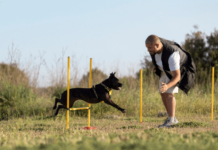Last Updated on August 25, 2023 by Dogs Vets
Best Shock Collar for German Shepherd? Myths vs. Facts
Are you a proud owner of a majestic German Shepherd? These intelligent and loyal companions deserve the best training to thrive as well-behaved members of your household and community.
When it comes to training tools, shock collars have garnered attention for their effectiveness in imparting discipline. However, choosing the best shock collar for your German Shepherd can be a daunting task.
We’ve meticulously researched and compiled a guide to help you make an informed decision, ensuring your furry friend’s well-being and obedience.
Understanding Shock Collars: Training Technology Unleashed
Shock collars, also known as e-collars or electronic training collars, are devices designed to aid in training dogs, including the intelligent and perceptive German Shepherds.
They operate by delivering a mild electric stimulus to the dog’s neck, allowing you to communicate commands effectively. Modern shock collars come with various settings, ensuring you can adjust the intensity to suit your dog’s temperament.
Key Considerations Before Choosing a Shock Collar
Before investing in a shock collar, it’s crucial to consider a few key factors to ensure you’re selecting the most suitable option for your German Shepherd:
- Temperament and Size: Your dog’s temperament plays a significant role in choosing the right collar. German Shepherds, known for their loyalty and protectiveness, may require a different level of correction compared to other breeds. Additionally, ensure the collar’s size is appropriate for your dog’s neck.
- Training Goals: Determine the specific training goals you want to achieve with the shock collar. Whether it’s curbing excessive barking, teaching commands, or addressing aggressive behavior, your goals will influence the collar’s features you need.
- Stimulation Modes: Look for collars that offer a variety of stimulation modes, such as vibration and tone, in addition to static stimulation. This allows you to find the most effective way to communicate with your dog.
The Controversy Surrounding Shock Collars: Myths vs. Facts
In recent years, shock collars have faced criticism, often surrounded by myths that need debunking. Let’s shed light on some common misconceptions:
- Myth: Shock collars are inhumane.
- Fact: When used responsibly and at appropriate levels, shock collars can be safe and effective tools for dog training.
- Myth: Shock collars always cause pain.
- Fact: The sensation delivered by modern collars is more of a startling feeling than intense pain. It’s vital to find the right level for your dog.
Training Tips: Maximizing Effectiveness of Shock Collars
Introducing your German Shepherd to a shock collar requires patience and a well-thought-out approach:
- Start Slowly: Begin with the lowest stimulation level, observing your dog’s response and comfort. Gradually increase the intensity as needed.
- Pair with Commands: Always associate the stimulation with a command. This helps your dog understand the desired behavior.
Incorporating Positive Reinforcement Alongside Shock Collars
Shock collars should be a part of a comprehensive training plan that includes positive reinforcement:
- Reward Good Behavior: Whenever your German Shepherd responds well to a command, reward them with treats, praise, or playtime.
- Consistency is Key: Ensure everyone involved in the training uses the same commands and techniques to avoid confusion.
The Verdict: Nurturing Obedience and Trust
Selecting the best shock collar for your German Shepherd requires careful consideration of your dog’s needs, temperament, and your training goals. Remember that shock collars are just one tool in a comprehensive training toolbox.
Combine their use with positive reinforcement, consistency, and patience to foster a strong bond of obedience and trust with your loyal companion.
FAQs
Are shock collars safe for German Shepherds?
A1: Yes, when used responsibly and according to the manufacturer’s instructions, shock collars can be safe and effective.
At what age can I start using a shock collar for my pup?
A2: It’s recommended to wait until your German Shepherd is at least 6 months old to start using a shock collar.
How do I correctly fit a shock collar on my German Shepherd?
A3: The collar should fit snugly but not too tight. You should be able to fit two fingers between the collar and your dog’s neck.
Can shock collars replace professional training?
A4: While shock collars can aid in training, they work best when used as part of a comprehensive training program that includes positive reinforcement and professional guidance.
What’s the range of these collars?
The range varies among different models but can range from 300 to 1000 yards.
Are there any potential long-term effects of using shock collars?
When used responsibly, there’s minimal risk of long-term effects. However, overusing or misusing shock collars can lead to stress or anxiety in dogs.
Can I use a shock collar for a timid German Shepherd?
It’s essential to assess your dog’s temperament. For timid dogs, start with the lowest stimulation level and observe their reaction.
Verified Sources and References:
Fact Check
We strive to provide the latest valuable information for pet lovers with accuracy and fairness. If you would like to add to this post or advertise with us, don’t hesitate reach us. If you see something that doesn’t look right, contact us!

















